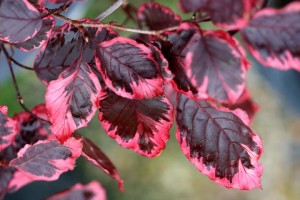 What is not to like about beech trees? They are high, wide and handsome at maturity, with big, spreading crowns and singular bark that looks remarkably like elephant skin. Birds and squirrels make homes in the branches and all kinds of creatures eat the annual harvest of beechnuts. Native American beech or Fagus grandifolia, is a large, landscape tree that can reach 70 feet tall and somewhat less in width at maturity. The toothed, ovoid green leaves color up in the fall, turning golden before leaving the scene.
What is not to like about beech trees? They are high, wide and handsome at maturity, with big, spreading crowns and singular bark that looks remarkably like elephant skin. Birds and squirrels make homes in the branches and all kinds of creatures eat the annual harvest of beechnuts. Native American beech or Fagus grandifolia, is a large, landscape tree that can reach 70 feet tall and somewhat less in width at maturity. The toothed, ovoid green leaves color up in the fall, turning golden before leaving the scene.
For some reason, American beech has not caught the fancy of plant breeders in the way that its European cousin, Fagus sylvatica or European beech has. The Old World variety is available in weeping, dwarf and variegated types. The species form bears lustrous green leaves, but many varieties have striking dark burgundy to purple-black foliage. Beech lovers are spoiled for choice.
Not long ago I came across an especially eye-catching European beech variety and now I am madly in love. The medium-size tree looked rosy pink from a distance, but closer inspection revealed that the leaves were actually purple variegated with dark pink. This stunning object of my latest horticultural crush is a variety that goes by the name ‘Purpurea Tricolor’ or ‘Roseomarginata’. Confusion reigns over names, but there is no confusion about the tree’s beauty. The leaves are as lovely and colorful as flowers.
The two Latin varietal names say it all. ‘Purpurea Tricolor’ features deep purple leaves accented with vivid rose and cream. The specimen that caught my eye sported foliage that was splashed with a wide pink edge surrounding the dusky purple center. Other tricolor varieties feature cream and pale pink in the leaf margins, and those margins can be slender or wide. It all seems to depend on the particular tree, its cultural conditions and the time of year. The deep purple eventually turns greenish as temperatures increase, but the dramatic effect remains. That said, I think the trees are at their loveliest in late spring, before the heat and the green coloration sets in.
Whether you call it ‘Purpurea Tricolor’ or ‘Roseomarginata’, this flashy variegated beech is no Johnny-come-lately. Woody plant expert Michael Dirr notes that it appeared in France in 1883. Other sources point to other years, but it is clear that the trees have been around since the last quarter of the nineteenth century, migrating to the United States from Europe.
Beech lovers not blessed with large swathes of property can rejoice in the fact that ‘Purpurea Tricolor’ lacks the mammoth dimensions of standard beech varieties. The trees top out at no more than 35 feet tall and 25 feet wide—not small, but manageable. It provides enough drama to be used as a single, specimen tree, but could also anchor a shade garden.
The variety is a classic understory tree, flourishing in conditions that mimic those of woodland edges—a mix of sun and light shade. If the tree gets too much sun, the leaf edges tend to scorch and curl up. Since you can’t apply sun block to a tree, it is best to find it a spot that meets its light needs.
Proper siting will also help the plant conserve water. This beech does not love extended periods of hot, dry weather, so mulching is necessary. A two-inch cover of mulch surrounding the tree in a circle with a two foot radius is perfect. Remember not to create a mulch “volcano”, with the mulch touching the tree bark. This practice, which is rather common, especially among commercial landscapers, promotes bacteria growth and disease.
When yard and garden space is at a premium, it is sometimes hard to commit to just one ornamental tree. ‘Purpurea Tricolor’ has a lot to recommend it. The yellow-green spring flowers are small and insignificant, but the leaves are gorgeous for the entire growing season. Combine that with attractive bark and a comely silhouette, and the variety becomes a strong contender for garden stardom.
Some large nurseries may carry ‘Purpurea Tricolor’ under that name or as ‘Roseomarginata’. It may also be listed as “Rose-Magret Variegated Beech”. Whatever name you use, ForestFarm nursery carries it. Find them at P.O. Box 1, Williams, Oregon 97544; (541) 846-7269; www.forestfarm.com. Print catalog: $5.00.
